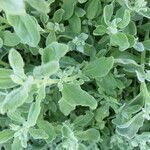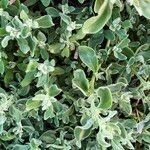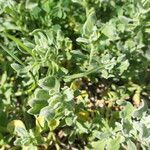Perennial herb, ± 0.5 m high; prostrate, covered with glistening papillae and some hairs, woody when old, terete but with narrow decurrent lines. Leaves narrow to base but not petiolate, oblong, obovate or nearly orbicular, edges recurved or revolute, papillose-hirsute. Flowers 3-5 per cyme. Perianth densely papillose, 4-lobed. Stamens many, yellow. Styles 4 or 5, or less in transitional flowers. Flowering time Dec., Jan. Fruit with 4 rigid wings, flat on top, small intermediate ridge between wings, yellow.
Sprawling perennial, with branches up to 1 m long. Leaves papillose-hirsute, obovate-oblong, fleshy. Flowers in branched axillary clusters, smaller than leaves, yellow. Fruit with rigid wings. Mainly Aug.-Nov.
Sepals free. Sprawling perennial with branches to 1 m. Leaves papillose-hirsute, obovate-oblong, fleshy. Flowers in branched axillary clusters shorter than leaves, yellow. Fruits with rigid wings.
A trailing herb or shrub. It grows 10-30 cm high. It can spread 2 m wide. The leaves are dark green. They are broad and succulent. The flowers are yellow. The fruit have 4 wings.



